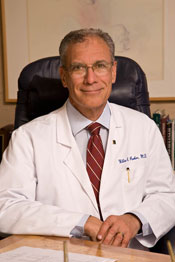Some people have recently suggested that all women have biopsies of their fibroids before surgery to determine which women have typical fibroids and which women might have a leiomyosarcoma (LMS). There are many problems with this idea.
To start, I am going to use the word tumor throughout this post. When we hear” tumor”, most of us (doctors included) think “cancer”. However, “tumor” means a growth and a growth can be benign or it can be malignant. Fibroids are a very common benign tumor of the uterine muscle cells (75% of women have them by age 50). Leiomyosarcoma is a very rare malignant tumor (see previous post) that starts in the uterine muscle wall. No one knows the causes of either fibroids or LMS, but it is now fairly well established that fibroids do not turn into LMS.
Fibroids are made up of uterine muscle cells, but also contain collagen and other proteins called proteoglycans. When the pathologist looks at a fibroid under the microscope, they see muscle cells that are very similar to one another and the cells appear to be dividing very slowly (very few mitoses). The diagnosis of fibroids is very easy for a pathologist to make.
The diagnosis of LMS under the microscope, however, is very hard. In order to make the diagnosis of a leiomyosarcoma many changes in the muscles cells need to be present: abnormal appearing cell nuclei (atypia); many cells that are dividing (mitoses); invasion of the cells into the surrounding tissue; breakdown of the cells (necrosis) and other features. All of these features need to be seen by the pathologist in order to make the diagnosis of LMS .
Another characteristic of LMS is that it is a very uneven tumor (heterogeneous), meaning that the cells can look almost normal in one area but very abnormal and aggressive in another area. Often, many areas of the tumor need to be examined before a diagnosis of a benign fibroid, atypical fibroid (mild abnormality) or LMS ( malignant) can be made. Even good pathologists can have trouble making the diagnosis of LMS because they see so very few of these tumors in their lifetimes. In my practice, whenever we have had any question about the diagnosis of a unusual-looking fibroid, I have the tissue sent for a second opinion to the world’s expert LMS pathologists at Stanford, Drs. Kempson and Hendrickson.
The next issue is that biopsy of fibroids before surgery would involve finding the fibroids using ultrasound, placing a needle through the abdominal wall into the uterus and fibroid, applying suction to collect cells and then withdrawing the needle and placing the cells into a container for the pathologist. The problem with a needle biopsy of a “fibroid” is that the needle will get a sample of only one very small area of the fibroid and there will be very few cells for the pathologist to examine. If the cells in that particular area look uniform, then the diagnosis will be fibroid, even if another area that has not been biopsied looks very abnormal and is, in fact, a LMS. Furthermore, frozen section, where a piece of tissue is removed from the tumor during surgery, immediately frozen, prepared and then examined by the pathologist is also very inaccurate because the freezing process distorts the LMS cells, which are already hard to diagnose. Proper preparation of the slides takes many hours.
An added problem is that most women have more than one fibroid. I have removed 150 fibroids from one woman (very unusual) and often need to remove more than 20. It would be technically impossible to biopsy every fibroid, and no woman would be able to tolerate the discomfort from multiple biopsies unless they were put to sleep with general anesthesia.
Because of all of these limitations, biopsying of “fibroids” is neither reasonable nor would it be accurate. That’s why we don’t do it.



